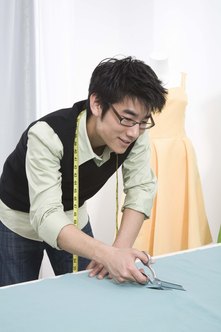
Getting a job as a patternmaker could be a stepping stone towards becoming a designer.
If you fancy embarking on a career as a fashion designer but don't want to spend three to four years at college before doing so, you'll be pleased to learn that a degree is not required to break into the profession, . If you've got enough raw talent and have picked up the basic skills necessary to secure an entry-level position in the fashion industry, there's a good chance you'll be able to make it without a bachelor's or associate's degree.
Assess whether you have the right qualities and skills to make it as a fashion designer. You'll need be creative, be detail-oriented and be able to illustrate your ideas. As many fashion designers use computer-aided design software as part of their work, such as packages from developers including Optitex, C-Design and TukaTech, you'll also need to be compute literate.
Step 2
Graduate from high school. Although you may not want to complete a bachelor's or associate's program in fashion design or a related subject, you could make yourself more attractive to potential employers if you have certificates or non-degree qualifications in relevant areas. You may need a high school diploma or the equivalent to be considered for even the most basic of entry-level jobs. While at high school, study art-related subjects and information technology to pick up computer skills.
Step 3
Attend textiles courses at your high school if they're available. If not, spend time in your city's fabric district or at local fabric stores. Making a swatch book using scraps of fabric collected from tailors and fabric shops will also be a productive use of your time.
Step 4
Start building up a portfolio of your ideas and designs. Developing a collection of your work from early on in your career will be vital. You'll need this to demonstrate your style and ability to potential employers.
Step 5
Learn to sew from books and magazines if you're dead against going to college. You can pick up titles in bookstores or online. If money's a bit tight, sniff out some secondhand books on advanced sewing and fabric manipulation techniques. Many books have been published on fashion-design related skills over the years, so you shouldn't have too much trouble tracking down some useful reading materials.
Step 6
Enter your designs into sewing competitions and fashion design contests such as those held by organizations such as the American Sewing Guild and Inspirare. As well as helping you hone your skills, doing well in contests such as these will add to your resume.
Step 7
Apply for internships with design or manufacturing firms. If you need to work part-time while you study or before you manage to land an entry-level fashion design role, get a job working as a personal stylist in a retail store. This will help you gain "sales and marketing skills while learning what styles and fabrics look good on different people," according to careers site ArtsBistro.
Step 8
Send speculative applications to companies you'd like to work for. Many fashion designers start their careers working as patternmakers or sketching assistants, according to the Bureau of Labor Statistics. Once you've built up some experience, contacts and your portfolio, start applying for design positions.